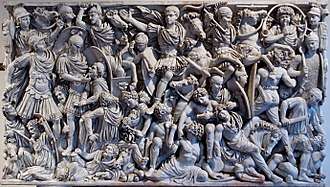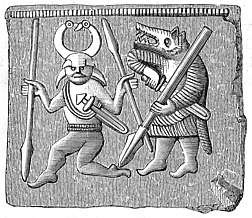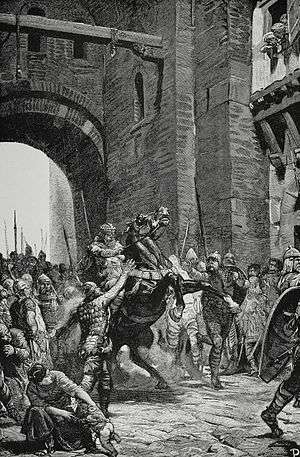Early Germanic warfare
Early Germanic warfare was the warfare of early Germanic peoples. It was a important element of early Germanic culture.
.jpg)
Sources
Most historical accounts of the early Germanic peoples are concerned with war. These include works by Greek and Roman scholars, and Germanic scholars writing in Latin.[1][2]
Accounts from Germanic literature often provide vivid descriptions of Germanic warfare, making it evident that warfare played a significant role in early Germanic culture. Treasures unearthed from Germanic graves have yielded large numbers Germanic weaponry, giving a glimpse into the ways they carried out war.[1]
Military history
Archaeological records indicate that the arrival of the Corded Ware culture in Northern Europe was accompanied by large-scale migration and warfare. After a period of amalgamation, the Nordic Bronze Age emerged, which appears to have been a time of relative peace.[1]
The military situation in the Germanic world was radically changed with the emergence of the Iron Age and the late centuries BC. For close to a thousand years afterward, the Germanic world was characterized by almost continuous warfare and large-scale migration.[1]
Though often defeated by the Romans, the Germanic tribes were remembered in Roman records as fierce combatants, whose main downfall was that they failed to join together into a collective fighting force under a unified command, which allowed the Roman Empire to employ a "divide and rule" strategy against them.[3]
On occasions when the Germanic tribes worked together, the results were impressive. Three Roman legions were ambushed and destroyed by an alliance of Germanic tribes headed by Arminius at the Battle of the Teutoburg Forest in 9 CE. As a result, the Roman Empire made no further concentrated attempts at conquering Germania beyond the Rhine.[4]
During the 4th and 5th centuries CE, Visigoths and Vandals militarily organized themselves to sufficiently challenge and sack Rome in 410 AD and again in 455 AD. Then in 476 AD, the last Roman emperor was deposed by the Germanic warrior Odoacer, an event which effectively ended Roman predominance in Western Europe.[5] Germanic tribes eventually overwhelmed and conquered the ancient world. That military transition was additionally spurred by the arrival of the Vikings from Scandinavia in the 8th to 10th centuries, giving rise to modern Europe and medieval warfare.[6]
The later military development of armored knights and fortified castles was a response in part to the relentless plundering and raiding by the Vikings, which meant that the Germanic tribes who had settled mainland Europe and the British Isles had to adapt themselves so as to combat another wave of Germanic aggression.[7]
Military training
In early Germanic society, all able-bodied members of the male population were accustomed to war. However, unlike in ancient Rome, there was no institutionalized system of military training. Instead, young males were trained from an early age by immediate male relatives.
It was considered essential in Germanic society for the elders to train the younger men in the art of war.[1]
Military organization
The basic principle in early Germanic military organization were the hundreds, who were organized on family relationships. This was the usual practice in the time of Tacitus (late 1st century AD). The organization of military units in "hundreds" enabled rapid assembly of armies and ensured a high degree of military morale.[1]
Germanic leaders of unusual personal magnetism could gather a retinue. The retinue (often called "comitatus" by scholars, following the practice of ancient Roman writers) consisted of the followers of a chieftain, who depended on the retinue for military and other services and who in return provided for the retinue's needs and divided with them the spoils of battle.[lower-alpha 1] Members of a comitatus would often be warriors from different groups of tribes. A member of a comitatus was expected to be completely loyal to his chieftain, and if he did not die on the battlefield with his lord, he was supposed to avenge his master. In return, the chief was expected to reward his followers liberally with food, shelter and weapons.[8]
Membership in a comitatus was voluntary, and a warrior could shift his allegiance to a different chief if he wanted to.[8]
The relationship between a chieftain and his followers became the basis for the more complicated feudal system that developed in medieval Europe. A chieftain's retinue might include close relatives, but it was not limited to them. Eventually the rising power of individual chieftains and kings from among the military leadership of Germanic tribes and confederations curtailed and in many ways replaced the power once enjoyed by tribal assemblies.[9]
Tactics

Early Germanic armies would generally attack in a wedge formation, referred to as svinfylking in Old Norse sources. Such attacks were accompanied by much shouting and noise. In a svinfylking attack the commander would lead from the front. As this was a dangerous position, the death of the commander was frequent, and would generally throw the military organization into confusion. A svinfylking formation was difficult to maintain, and a battle would therefore develop into a fight between individuals or small groups. Under such conditions, managing a strategic retreat was a difficult task, resulting in panics in which it was every man for himself. The Battle of Vosges between Ariovistus and Julius Caesar in 58 BC is a typical example of such a fight.[1]
The berserker mentality employed by the Germanic tribes against Rome was still in effect during the Viking Age of the 8th and 9th centuries as they too believed that by summoning their gods and working themselves up, they would possess superhuman strength and be protected during battle. Such resolution led them to believe that dying in such a manner was heroic and would transport the fallen fighter straight into Valhalla where they would be embraced by the warrior maidens known as the Valkyries.[10][lower-alpha 2]
"Germans.. are of robust bodies and fall upon their enemies as soon as ever they are attacked by them; and which way soever they go, they perform great exploits."" - Josephus[11]
In later the Germanic ware, the commander would no longer lead from the front. Germanic armies had also learned the advantage of maintaining reserves, rather than throwing the entire army into battle at the same time.[1]
Forms of warfare
The three main types of warfare carried out during the Germanic Iron Age were feuds, raids and total war involving the entire tribe.[1]
Feuds
The prevalence of feuds in early Germanic warfare is well attested in the Sagas of Icelanders and other Germanic poems such as Beowulf. Since quarrels between individuals were at the time not regulated by any form of tribal law, feuds became in many cases the only way to obtain remedy for an injury.[1]
Raiding
Raids were typically carried out by the early Germanic peoples either for the purpose of acquiring booty or for scouting for areas suitable for colonization.[1]
Such raids were typically organized by individual leaders who would invite all whom were interested in joining him on his quest.[1]
According to Caesar, a Germanic chieftain would typically announce a raid at the popular assembly and call for volunteers. Such raids did not necessarily involve the entire tribe, but must rather be considered private ventures. According to Tacitus, chieftains would utilize raids as a form of military training.[1]
The purpose of a raid was not to gain territory, but rather to capture resources and secure prestige. These raids were conducted by irregular troops, often formed along family or village lines, in groups of 10 to about 1,000.[2] Large bodies of troops, while figuring prominently in the history books, were the exception rather than the rule of ancient warfare. Thus a typical Germanic force might consist of 100 men with the sole goal of raiding a nearby Germanic or foreign village. Thus, most warfare was at their Germanic neighbors.[2]
Larger migrations were generally preluded by raids. A significant example of this is the Anglo-Saxon settlement of Britain, which had been preceded for centuries by naval raids on Roman Britain.[1]
Cavalry was rarely used by Germanic raiders.[1]
Total war
Wars involving entire tribes were uncommon in the Germanic world until the Iron Age. One the earliest Germanic peoples involved in such warfare were the Bastarnae, who are mentioned in classical sources as battling the Illyrians in Southeast Europe in the 3rd and 2nd centuries BC.[1]
When engaged in total war, Germanic armies often consisted of more than 50 percent noncombatants, as displaced people would travel with large groups of soldiers, the elderly, women and children.[2]
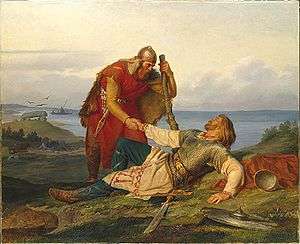
In Getica, the 6th century Gothic historian Jordanes mentions a series of mass-migrations of the Goths from Scandinavia towards the Black Sea, but the accuracy of his writing has been put up to question. Other major tribal migrations taking place in the Migration Period include that of the Vandals, Lombards, Burgundians and Anglo-Saxons. During such migrations the entire tribe would move along with their belongings on ox-drawn wagons, not unlike the American pioneers hundreds of centuries later.[1] When such folk-armies were forced to fight, a wagon fort would be established, where the women and children were provided shelter.[1] Such large-scale migrations required skilled leadership. Many of the most famous early Germanic kings, such as Alaric I, Theodoric the Great, Genseric and Alboin, are remembered for leading their people on such migrations.[1]
The earliest of Germanic mass migrations are not recounted in classical literature, and clews about such events can only be derived from archaeological discoveries.[1]
Aftermath of a battle
Victory
After a victorious battle, Germanic warriors would normally attend only the dead and wounded of their own side. Enemy dead would generally be left to be devoured by birds and beasts of prey. This process is described vividly in many pieces of early Germanic literature.[1]
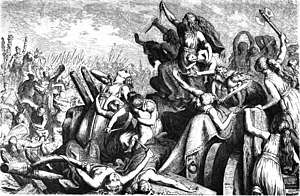
In case of victory, the booty would be divided among the troops, often by the casting of lots. Sometimes the booty, including prisoners, would be sacrificed to the god of war. This was infamously done by the Cimbri to Roman soldiers captured during the Cimbrian War.[1]
Defeat
Legitimacy for Germanic chieftains resided in their ability to successfully lead armies to victory. Defeat on the battlefield at the hands of the Romans or other barbarians often meant the end of a ruler and in some cases, being absorbed by "another, victorious confederation."[12]
It was reported in Roman sources that upon being defeated, Germanic women would kill their own children and commit suicide in order to avoid slavery. This was done by the Cimbri women following the defeat of their tribe by the Romans at the Battle of Vercellae in 101 BC.[1]
Cavalry
.jpg)
While Germanic warfare emphasized the use of infantry, they were quite adept at the training and use of cavalry. In Germanic warfare, cavalry was generally used for reconnaissance, flanking, the pursuit of fleeing enemies and other special tasks.[1]
When Germanic tribes were on the march, their wagons would generally be protected by cavalry. Early Germanic chieftains were typically mounted. This is attested from numerous horse burials in the graves of Germanic leaders.[1]
Early Germanic cavalrymen commonly used spurs to properly control the horse. The stirrup was later introduced. This enabled the easier mounting and maintenance of balance. The fact that the stirrup was introduced at such a late date is a testimony to the excellent horsemanship of Germanic riders.[1]
Caesar notes that the Suebi would attach a fast-running warrior to each cavalryman, who could assist the latter with both defense and offense.[1]

Caesar considered Germanic cavalrymen superior to those of the Romans, and was thus forced to recruit Germanic mercenaries to compensate for this inferiority. The Germanic horses were however of smaller size than those of the Romans, and Germanic cavalrymen in Roman service were thus compelled by Caesar to ride Roman horses.[1][13]
Naval warfare
Naval warfare became an important component of Germanic warfare, particularly raiding. Ships were ideal for raiding because they enabled increased mobility and secrecy, which was essential for the success of a raid.[1]
For the early Germanic peoples, boats were primarily used for transportation. Certain tribes along the North Sea coast, such as the Saxons, fought naval battles during their raids on Roman territory. During the Viking Age the North Germanic peoples mastered the construction of the Viking ship and excelled at naval warfare.[1]
Siege equipment
It was only during their southwards expansion in the Roman Iron Age that the Germanic peoples became familiar with fortified towns. At first they were unable to successfully besiege such targets, and were therefore compelled to attack the countryside instead.[1][10]
From the Romans, Germanic warriors would eventually learn how to use siege towers and battering rams to overcome advanced fortifications. On occasion they would rather bribe inhabitants to open the gates. The most common way for Germanic armies to defeat fortified settlements was to force a town into submission by a blockade.[1]
Fortifications
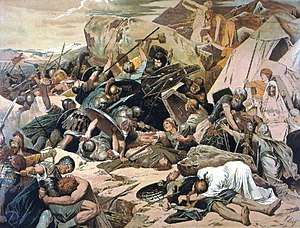
Roman accounts of Germanic warfare contain few references to fortifications being used. When however besieged while occupying a Roman city, they would defend themselves stubbornly.[1]
Archaeological discoveries show that Germanic villages were largely undefended, the only defense being small strips of wasteland maintained between tribes.[1] According to Caesar, having a large area of wasteland surrounding its territories was considered a sign of military prowess for a Germanic tribe.[14]
A small amount of fortifications have however been discovered. These appear to have been places of refuge for the non-fighting population.[1] Such fortifications generally consisted of a double-earth wall and a trench.[1]
Logistics
A key advantage of early Germanic armies was their mobility. For long-term conflicts they would usually bring all their supplies with them. For short term engagements, they brought with them few supplies and rather lived off the land. This would often cause severe devastation to areas in which Germanic warriors fought.[1]
For logistical reasons, early Germanic peoples generally carried out war in summer, bus as they expanded southwards at the expense of the Romans, they were able to fight in the winter as well.[1]
Chariotry

Unlike their Celtic neighbors, the use of chariots was not widespread among Iron Age Germanic peoples.[15] Germanic peoples had used the horse-drawn war-chariot in the Bronze Age, but later gave it up.[14]
Mercenary activity
Germanic warriors frequently fought as mercenaries in the Roman army. Some of these mercenaries, such as Stilicho, rose to prominent positions. According to Francis Owen, the Western Roman Empire would have collapsed much earlier without such mercenaries.[1]
Returning Germanic mercenaries in the Roman army brought back many Roman products to their communities. This had a major impact on Germanic culture.[16]
Wargear
Early Germanic warriors were typically buried with their belongings, including weapons and armor. Such burials provide valuable information on the weapons and armor of Germanic tribes, even when the body was cremated. It is evident that Germanic wargear was designed for offensive warfare[17] and increased mobility.[1]
Weapons
Already in the Nordic Bronze Age, Germanic smiths were making swords and axes in bronze of very high quality. This metal had to be imported, and due to the lack of metal, only a few elite warriors had access to such weapons.[1]
For many centuries, due to the lack of metal, the chief weapon for Germanic warriors was the spear.[1]
Most of the swords used by the Germanic warriors were those captured from Roman soldiers until the 4th century when Germanic smiths began making the best steel in Europe.[18]
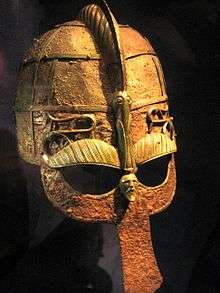
During the later parts of the Iron Age, as iron ore became more available, the sword became the chief Germanic weapon. Such swords came in many types, which varied from time to time. Magical swords play an important role in early Germanic literature.[1]
The shield was the main defensive weapon of a Germanic warrior. Such shields were generally of wood and covered with hide. The edge was made firm with iron, and the centre contained an iron shield-knob, which was to protect the hand of the warrior who wielded the shield.[1]
Clubs and axes were also common Germanic weapons.[19] Bows were rarely used by Germanic warriors in ancient times, although the Vikings later used them freely.[1]
Armor
Helmets and armors have been found in early Germanic graves, usually of leaders.[20][19] The armor generally consisted of thousands of rings, a so-called ring-mail. The ring-mail is vividly described in Beowulf.[1]
For the average Germanic warrior, leather was the only protection. Tacitus describes that many Germanic warriors had no protection at all.[1]
Commandeering of Roman weaponry was widespread and the acquisition of the superior Roman armaments allowed the Germanic leaders to exert their power in ways not previously available. It also meant fierce inter-Germanic rivalry which constituted the larger power blocks of the Germanic world.[21]
See also
| Wikimedia Commons has media related to |
- Celtic warfare
- Germanic Wars
- Gothic and Vandal warfare
- Anglo-Saxon warfare
Notes
- See:Encyclopædia Britannica, Comitatus
- Warriors were physically adept and owed much of their esprit de corps to the loyalty existing between themselves and their tribal chieftains. After forming a shield wall, they would then hurl a single spear in unison as a sacrifice to Odin. Fighting thereafter normally devolved to a gang raid and individual combat. See: Waldman & Mason 2006, p. 837.
References
- Owen 1960, pp. 119-133.
- Geary 1999, p. 113.
- Archer et al. 2008, p. 105.
- Roberts 1996, pp. 65–66.
- Daniels & Hyslop 2014, p. 85.
- Waldman & Mason 2006, p. 836.
- Waldman & Mason 2006, pp. 322–323.
- Owen 1960, pp. 153-166.
- Todd 2009, pp. 31–32.
- Waldman & Mason 2006, p. 322.
- Josephus 1936, p. 589 [The Antiquities of the Jews. Book XIX. 15].
- Geary 1999, p. 112.
- Todd 2009, pp. 36–37.
- Owen 1960, pp. 166-174.
- Todd 2009, p. 37.
- Owen 1960, pp. 174-178.
- Bémont & Monod 2012, pp. 485–486.
- Waldman & Mason 2006, p. 321.
- Santosuo 2004, pp. 143–144.
- Waldman & Mason 2006, pp. 321–322.
- Heather 2005, pp. 458–459.
Bibliography
- Archer, Christon I.; Ferris, John R.; Herwig, Holger; Travers, Timothy H. E. (2008). World History of Warfare. Lincoln, NE: University of Nebraska Press. ISBN 978-0-8032-1941-0.CS1 maint: ref=harv (link)
- Bémont, Charles; Monod, Gabriel (2012). Medieval Europe, 395–1270. Lecturable [Kindle Edition]. ASIN B00ASEDPFA.CS1 maint: ref=harv (link)
- Daniels, Patricia; Hyslop, Stephen (2014). Almanac of World History. Washington DC: National Geographic. ISBN 978-0-7922-5911-4.CS1 maint: ref=harv (link)
- Geary, Patrick J. (1999). "Barbarians and Ethnicity". In G.W. Bowersock; Peter Brown; Oleg Grabar (eds.). Late Antiquity: A Guide to the Postclassical World. Cambridge, Massachusetts: The Belknap Press of Harvard University Press. ISBN 978-0-674-51173-6.CS1 maint: ref=harv (link)
- Heather, Peter (2005). The Fall of the Roman Empire: A New History of Rome and the Barbarians. Oxford and New York: Oxford University Press. ISBN 978-0-19-515954-7.CS1 maint: ref=harv (link)
- Josephus, Titus Flavius (1833). Early Germans. Kimber & Sharpless.CS1 maint: ref=harv (link)
- Owen, Francis (1960). The Germanic People. New York: Bookman Associates.CS1 maint: ref=harv (link)
- Roberts, J. M. (1996). A History of Europe. New York: Allen Lane. ISBN 978-0-9658431-9-5.CS1 maint: ref=harv (link)
- Santosuo, Antonio (2004). Barbarians, Marauders, and Infidels: The Ways of Medieval Warfare. New York: MJF Books. ISBN 978-1-56731-891-3.CS1 maint: ref=harv (link)
- Todd, Malcolm (2009). The Early Germans. John Wiley & Sons. ISBN 9781405137560.CS1 maint: ref=harv (link)
- Waldman, Carl; Mason, Catherine (2006). Encyclopedia of European Peoples. New York: Facts on File. ISBN 978-0-8160-4964-6.CS1 maint: ref=harv (link)
Further reading
- France, John; DeVries, Kelly (2008). Warfare in the Dark Ages. Ashgate. ISBN 978-0754625575.CS1 maint: ref=harv (link)
- Haywood, John (2006). Dark Age Naval Power: A Reassessment of Frankish and Anglo-Saxon Seafaring Activity. Anglo-Saxon Books. ISBN 1898281432.CS1 maint: ref=harv (link)
- Härke, Heinrich (February 1990). ""Warrior Graves"? The Background of the Anglo-Saxon Weapon Burial Rite". Past & Present. Oxford University Press (126): 22–43. JSTOR 650808.CS1 maint: ref=harv (link)
- MacDowall, Simon (2000). Germanic Warrior 236-568 AD. Blumsbury USA. ISBN 1841761524.CS1 maint: ref=harv (link)
- MacDowall, Simon (2005). Adrianopole, AD 378: The Goths Crush Rome's Legions. Praeger. ISBN 027598835X.CS1 maint: ref=harv (link)
- Musset, Lucien (1975). The Germanic Invasions: The Making of Europe, AD 400-600. Paul Elek. ISBN 023617620X.CS1 maint: ref=harv (link)
- Powell, Lindsay (2014). Roman Soldier vs Germanic Warrior: 1st Century AD. Bloomsbury Publishing. ISBN 978-1472803511.CS1 maint: ref=harv (link)
- Price, Arnold Hereward (1996). Germanic Warrior Clubs: An Inquiry Into the Dynamics of the Era of Migrations and Into the Antecedents of Medieval Society. UVT. ISBN 3924898219.CS1 maint: ref=harv (link)
- Shadrake, Ben; Shadrake, Susanne (1997). Barbarian warriors: Saxons, Vikings, Normans. Brassey's.CS1 maint: ref=harv (link)
- Speidel, Michael P. (Fall 2002). "Berserks: A History of Indo-European "Mad Warriors"". Journal of World History. University of Hawaii Press. 13 (2): 253–290. doi:10.1353/jwh.2002.0054. JSTOR 20078974.CS1 maint: ref=harv (link)
- Speidel, Michael P. (2004). Ancient Germanic Warriors: Warrior Styles from Trajan's Column to Icelandic Sagas. Routledge. ISBN 1134384203.CS1 maint: ref=harv (link)
- Steuer, Heiko (2004). "Warrior Bands, War Lords, and the Birth of Tribes and States in the First Millennium AD in Middle Europe". In Otto, Ton; Thrane, Henrik; Vandkilde, Helle (eds.). Warfare and Society: Archaeological and Social Anthropological Perspectives. ISD LLC. pp. 227–236. ISBN 8779349358.CS1 maint: ref=harv (link)
- Thompson, E. A. (November 1958). "Early Germanic Warfare". Past & Present. Oxford University Press (14): 2–29. JSTOR 650090.CS1 maint: ref=harv (link)
